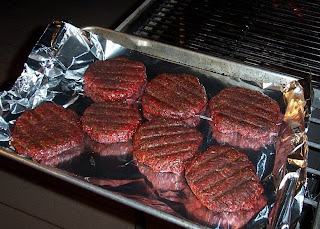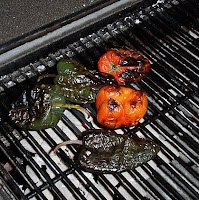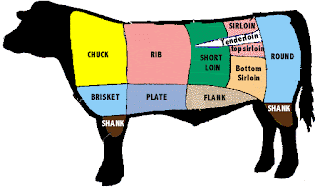Human history is filled with moments of breathtaking discovery. Lewis & Clark’s first glimpse of the mighty Pacific, Watson and Crick’s unraveling of DNA, Armstrong and Aldrin’s dusty steps on the moon, Edmund Hillary and Sherpa Tenzing Norgay’s ascent of Mt. Everest. Add to this epic list, Tom and Brian’s smoked hamburgers.

My first love - a Mecco electric water smoker
First, a little history. Back in the 20th century I purchased my first smoker and a copy of an excellent smoker cookbook called Smoke & Spice. For years I referred to it when making traditional smoker favorites like ribs, pork shoulder and smoked sausages. I would often leisurely thumb through the book and was always intrigued by a recipe for “Humdinger Hamburgers”. For some reason, other than the corny name, I never gave them a try despite their relatively short smoking time, which makes them one of the easiest recipes in the book. I never put them out of mind and knew one day I’d see if they were as good as the book promised. Turns out, they were better.
If you want to smoke food, get this book.
Fast forward ten years. Our church was having its annual Men’s Barbecue Competition and my friend Brian suggested we enter. We strategized about our entry. Tri-tip – tir ed and cliché: Ribs – also overdone and difficult to pull off at a remote location. We had done a prototype of smoked hamburgers a few months prior so we decided to try them in earnest for the competition. Risky? Yes, but we might as well go down swinging.
ed and cliché: Ribs – also overdone and difficult to pull off at a remote location. We had done a prototype of smoked hamburgers a few months prior so we decided to try them in earnest for the competition. Risky? Yes, but we might as well go down swinging.
I admit I wanted to put as much wind in our sails as possible, so rather than buy pre-ground beef I bought a chuck roast and sirloin ‘flap meat’ (looks like skirt steak) to grind up fresh. Brian brought his son Sam over and we ground the meat on my Kitchen Aid grinder. We dusted the patties with a traditional barbecue spice and placed t hem in the smoker. While they smoked over oak wood Brian and Sam headed to the church to light our charcoal grill parked in the staging area. After 90 minutes of smoking I shuttled the burgers over to the church.
hem in the smoker. While they smoked over oak wood Brian and Sam headed to the church to light our charcoal grill parked in the staging area. After 90 minutes of smoking I shuttled the burgers over to the church.
After the smoking period the patties had a stunning mahogany patina. Unlike a grilled patty that shrinks, tightens and balls up while cooking, these had shrunk very little. Combined with the raw looking interior, they looked undercooked but I’m convinced they had reached at least 135 degrees in the center. Regardless, we finished them over direct heat on the grill for a crispy exterior and to melt the cheese.
Gentle cooking = juicy meat and minimal shrinkage. Look at that color!
We wanted to win the contest and didn’t know how these would turn out, so as an insurance policy we made sure the condiments were top shelf. Brian made a caramelized onion spread and I grilled red, orange and red bell peppers over an oak wood fire. We placed a roasted pepper on each patty and topped them with a slice of Tillamook black label aged white cheddar. We warmed the buns on the grill and gave them a smear of onion spread before laying the patties down. The flavor? Impossible to capture in words. Intense smokiness that didn’t overpower the juicy beef flavor. The sweet peppers and tangy cheddar were perfect counterpoints. We called our entry “The Smoked Offering” because I felt like I should honor God for creating such transcendent flavors for us to discover (btw, we won the contest but our real reward was the burger).
a roasted pepper on each patty and topped them with a slice of Tillamook black label aged white cheddar. We warmed the buns on the grill and gave them a smear of onion spread before laying the patties down. The flavor? Impossible to capture in words. Intense smokiness that didn’t overpower the juicy beef flavor. The sweet peppers and tangy cheddar were perfect counterpoints. We called our entry “The Smoked Offering” because I felt like I should honor God for creating such transcendent flavors for us to discover (btw, we won the contest but our real reward was the burger).
I reported the results to my friend Tony who promptly made the 3.5 hour drive with his wife to our house to make smoked hamburgers. The photos on this post are from his visit. This time I simplified the process a little with good quality ground chuck from the butcher. Not a problem - we climbed Everest again.

Don't be fooled by the raw look. It's cooked through but with
incredible flavor, texture and juiciness.
I use a New Braunfels smoker but these can be made on a charcoal grill or probably a gas grill that has a little smoker box for chips. Just have the fire on one side, add chunks or chips of wood, cover and keep the temperature in the cooking area around 225 degrees. I recommend finishing the burgers for just a minute over direct heat. And please don't destroy them with "bbq sauce".


 I didn’t want to waste all the precious fond in the browning pot so I deglazed it with some Port and basted the roast with it through its cooking time. I had enough left that I simmered it down to make a port wine reduction to drizzle over the slices. I unapologetically use a digital meat thermometer to monitor the internal temp of roasts and was amazed at how quickly and steadily the temperature rose in this one despite the low oven temp. I kept backing the oven temp off until I finally just turned it off and let the residual heat finish the cooking. When it hit 130 I pulled and let it rest while I finished the side dishes. The digital thermometer probably saved me from a disaster.
I didn’t want to waste all the precious fond in the browning pot so I deglazed it with some Port and basted the roast with it through its cooking time. I had enough left that I simmered it down to make a port wine reduction to drizzle over the slices. I unapologetically use a digital meat thermometer to monitor the internal temp of roasts and was amazed at how quickly and steadily the temperature rose in this one despite the low oven temp. I kept backing the oven temp off until I finally just turned it off and let the residual heat finish the cooking. When it hit 130 I pulled and let it rest while I finished the side dishes. The digital thermometer probably saved me from a disaster.










